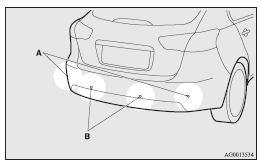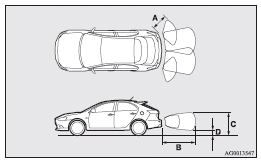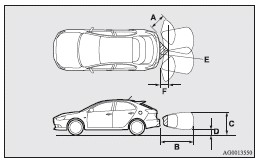
Mitsubishi Lancer Owners Manual
Obstacle detection areasStarting and driving / Reversing sensor system / Obstacle detection areas
The detection areas of the corner and back sensors are limited to those shown in the illustration. Moreover, the sensors are unable to detect low or thin objects or objects near the rear bumper. Thus, make sure to check the surroundings as you operate the vehicle in a safe manner.
Corner and back sensor locations
There are two corner sensors (A) at the corners of the rear bumper, and two back sensors (B) in the centre of the rear bumper.

Reversing sensor system detection areas
Depending on whether the vehicle is equipped with a towing bar, you can change the reversing sensor system between the standard mode and the towing bar mode. The towing bar mode changes the system to exclude the area in which the towing bar is mounted from the detection areas.
Vehicles without a towing bar
The detection areas are within approximately 60 cm (A) from the corner sensors, 150 cm (B) from the back sensors, and 60 cm (C) or less from the ground surface, excluding the area approximately 10 cm (D) from the ground surface.

Vehicles with a towing bar
The detection areas are within approximately 60 cm (A) from the corner sensors, 150 cm (B) from the back sensors, and 60 cm (C) or less from the ground surface, excluding the area approximately 10 cm (D) from the ground surface. The non-detection areas (E) are within approximately 20 cm (F) from the bumper.

![]() Note
Note
► If the rear bumper has been exposed to an impact, the corner or back sensors
may fail and prevent the system from functioning properly.
Have the vehicle inspected at a MITSUBISHI MOTORS Authorized Service Point.
► The sensors do not detect objects located in the area directly below or near the
bumper. If the height of an object is lower than the mounted position of the corner
or back sensors, the sensors may not continue detecting it even if they detected
it initially.
For information on how to change the detection areas, please refer to “Changing the detection areas”.
![]()
► The reversing sensor system may not operate properly under the following
conditions:
• The sensors or surroundings are covered with ice, snow, or mud.
• The sensors are frozen.
• The system receives ultrasonic noise from other sources (the horns of other vehicles,
motorcycle engines, brakes, radios, pouring rain, splashing water, tyre chains,
etc.).
• The sensors are extremely hot or cold (while the vehicle is parked for a long
period of time under a blazing sun or in cold weather).
• The vehicle tilts significantly.
• The vehicle is driven on a rough road (with a bumpy, gravel, hilly, or grassy
surface).
• The vehicle is too close to an obstacle.
• The sensors or surroundings have been wiped by hand, or stickers or accessories
have been attached.
► The reversing sensor system may not properly detect the following:
• Objects that are thin, such as wire nets or ropes.
• Objects that absorb sound waves, such as snow.
• Objects that are shaped with a sharp angle.
• Objects with a smooth surface, such as glass.
• Objects that are low, such as kerbstones.
![]() Note
Note
► The buzzer may sound lower than the normal warning sound when the reversing sensor system is receiving ultrasonic noise from other sources, but this is not a malfunction. The buzzer will stop sounding and the system will return to normal operation after the noise is no longer received.






